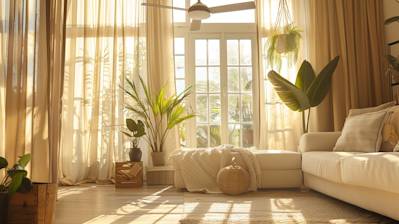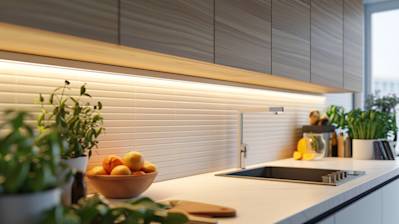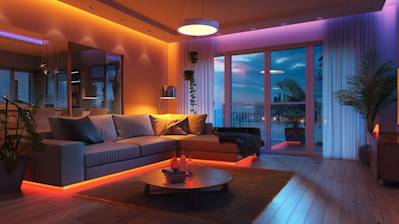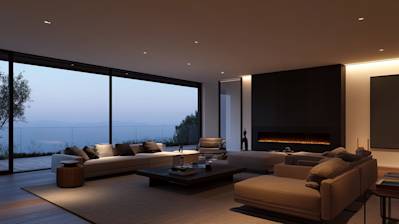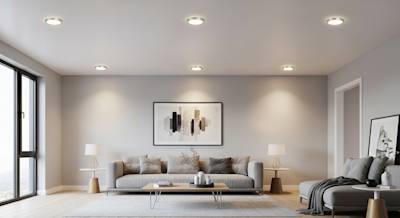Can lights, also known as recessed lighting, are an elegant and modern choice for illuminating your indoor or outdoor spaces. Their primary attribute, being recessed into the ceiling, walls or other surfaces, ensures they provide focused and direct light while staying out of sight. If you're considering installing can lights in your home or commercial spaces, this definitive guide will broaden your understanding on their artistic, functional and technical aspects.
Understanding Can Lights: An Overview
Featuring a minimalist appearance, can lights - also known as down lights or pot lights - are lighting fixtures that get their name from their cylindrical 'can' shape. They're typically installed via recessed holes in the ceiling, walls or ground. Their unique design facilitates stylish and seamless illumination without any visible hanging parts or shades.
Where Can Lights are Typically Utilized
Due to their concealed nature and ability to cast a spotlight-like effect, these versatile lighting fixtures can be used effectively in various settings, both at homes and commercial spaces. Some typical applications include:
-
General room lighting: Can lights are often evenly distributed to modernly illuminate living rooms, bedrooms, dining rooms, and kitchens.
-
Task lighting: They can be installed under kitchen cabinets or above work spaces for a clear, focused light.
-
Accent lighting: Can lights are great for highlighting artworks, decorative accents, bookshelves, or architectural features of a room.
-
Outdoor lighting: These lights illuminate pathways, architectural features or landscape elements.
Varieties of Can Lights
Can lights are available in a wide range of styles, sizes, and configurations catering to different needs and preferences. Here are some commonly used types:
-
IC rated can lights: Made for insulation contact, these are safe to install where they will be in contact with insulation without leading to fire risks.
-
Non-IC rated can lights: These require a clearance from insulation to prevent overheating and can be used where insulation is not a concern.
-
Remodel can lights: Easy to install in an existing ceiling, these are perfect for renovation or remodel project.
-
New construction can lights: Often used during the initial stages of construction, these are installed before the ceiling is up.
Choosing the Correct Size of Can Lights
Can lights come in different sizes, the most common being 4", 5" and 6" in diameter. Smaller can lights are suitable for accent and task lighting, while bigger ones are ideal for general room illumination.
Selecting the Suitable Trim
The trim is the visible part of the recessed lighting, available in various styles such as baffle, reflector, eyeball, gimbal, and more. It should be chosen keeping in mind the desired lighting effects and environmental conditions.
Installation Process for Can Lights
Installing can lights requires technical knowledge and electrical wiring expertise. It involves cutting holes in the ceiling, running cables, fitting the light cans, installing the trim, and setting up the bulbs. Always consult or hire a licensed electrician to ensure the safe installation and setup of your can lights.
Light Bulbs for Can Lights
Depending on your can lights, you can use various types of light bulbs, including LED, halogen, and CFL. LED can light bulbs provide energy-efficient and long-lasting lighting options with diverse color temperature choices.
Safety Precautions with Can Lights
When dealing with can lights, it is essential to follow safety guidelines, such as maintaining a safe distance from flammable materials, using insulated fixtures where necessary, and always turning off the power before starting the installation or bulb changing process.
By understanding the principles outlined in this guide, you can make a well-informed decision on pressing ahead with can lights for your residential or commercial needs. Remember, it's not only about lighting a room – it's about creating a visually captivating ambiance while ensuring functionality and efficiency.
Frequently Asked Questions (FAQ) about Can Lights
What differentiates can lights from other lighting fixtures?
Can lights, also known as recessed lights, are lighting fixtures that are installed into hollow openings in the ceilings. Unlike other hanging light fixtures, can lights are concealed and flush with the ceiling, providing a streamlined and modern aesthetic.
What are the different types of can lights available?
There are primarily three types of can lights: new construction, remodel, and retrofit. New construction can lights are used when the ceiling is accessible from above, typically in new buildings. Remodel can lights are used in existing ceilings where access is only available from below. Retrofit can lights are designed to fit into existing can lights.
Is it possible to install can lights in a finished ceiling?
Yes, you can install can lights in a finished ceiling. Remodel can lights and retrofit can lights are designed for just such a scenario. However, installation in a finished ceiling may be a bit more complex and may require professional help.
How many can lights are needed for a specific room size?
The number of can lights needed will largely depend on the size of your room and what you intend to illuminate. As a general rule, experts recommend placing can lights approximately two feet away from the wall and four to six feet apart from each other.
Can I use LED bulbs with can lights?
Yes, LED bulbs can be used in most can light fixtures and are often preferred due to their energy efficiency and longevity. Making sure the bulb size is compatible with your light fixture is essential.
Are can lights energy efficient?
Can lights have the potential to be very energy efficient, especially when fitted with LED or CFL bulbs. The efficiency also depends on the wattage of the bulb and how long the light is turned on for.
Can you install can lights outdoor?
Yes, but it is crucial to use specially designed outdoor can lights that are water and weather resistant. These fixtures are designed for exposed areas and can withstand various weather conditions.
Can I adjust the direction of light in a can light?
Some can lights come with an adjustable gimbal that allows you to tilt the light in a particular direction. This is especially useful when you want to highlight certain architectural elements or art pieces in your room.
Do can lights require special wiring?
Like any other electrical fixture, can lights do require internal wiring. For new constructions or significant remodeling projects, wiring is planned and installed during construction. For retrofit or remodel fixtures, existing wiring should be sufficient.
Do can lights generate heat?
All light fixtures generate some heat, and can lights are no exception. However, LED or CFL bulbs emit significantly less heat than traditional incandescent bulbs, making them a safer choice for can lights.
Pros and Cons of Can Lights
Pros of Can Lights
Efficiency
Can lights, also known as recessed lighting or pot lights, are notable for their efficiency. Here's why:
-
Space Saving: Since can lights are installed within the ceiling, they do not occupy much space. This makes can lights the perfect lighting solution for rooms with low ceilings or those with limited space available for lighting fixtures.
-
Energy Saving: Can lights can be equipped with energy-saving bulbs. In comparison to standard incandescent lamps, the energy use can be lowered considerably, resulting in significant savings on utility bills over the long run.
Versatility and Adaptability
Next, flexibility stands as one of the greatest strengths of can lights.
-
Design Flexibility: Can lights can be used in almost any room. They are suitable not only for home settings such as living rooms, bedrooms or bathrooms but also for commercial environments like offices, bars, or stores.
-
Directional Lighting: Some can lights can be adjusted to highlight specific areas or features in a room. This makes them ideal for use as accent lighting or task lighting.
Elegance and Aesthetics
Among the many advantages of can lights, aesthetics cannot be overlooked.
-
Clean Look: Can lights provide a neat, streamlined look to space because of their recessed design. There are no hanging parts or wires, which adds to the minimalist appeal.
-
Accentuates Features: The adjustable nature of some can lights allows for the illumination of key features in a room, such as a mantelpiece or artwork. This can help to enhance the overall aesthetics of the space.
Cons of Can Lights
Installation Challenges
Despite the many advantages, there are also drawbacks to consider when thinking about installing can lights:
-
Professional Installation: Due to the fact that they're installed into the ceiling, can lights usually require professional installation. This can make the process more costly and time-consuming than other types of lighting that can be installed DIY.
-
Limitations in Placement: Because can lights require a hollow space above the ceiling for installation, they may not be suitable for concrete ceilings or areas where there is wiring, ducting, or piping above the ceiling.
Lighting Limitations
Lighting limitations are another factor to consider when evaluating the downsides of can lights:
-
Lack of Ambient Light: While can lights are ideal for task lighting or accent lighting, they may not be capable of providing an adequate amount of ambient light alone, compared to other fixtures such as chandeliers or pendant lights.
-
Glare Issue: Some users complain about the harsh glare that can lights can create, especially if they are installed inappropriately or if high-wattage bulbs are used. This can be a significant downside for people with light sensitivities.
Energy Efficiency and Heat Dissipation
Last but not least, let's not overlook the issues that may arise with respect to energy efficiency and heat dissipation:
-
Insulation Contact (IC) versus Non-Insulation Contact (Non-IC): In some cases, can lights may not be safe to install directly adjacent to insulation (non-IC) and can potentially pose a fire hazard if done incorrectly. On the other hand, insulation contact (IC) can lights can directly contact insulation but often come with a higher price tag.
-
Heat Dissipation: Can lights, particularly those utilizing incandescent or halogen bulbs, can emit a significant amount of heat. This may lead to discomfort if the lights are left on for extended periods or cause damage if insulation or materials around the fixture are not heat-resistant.
Summary
Overall, using can lights is a great way to introduce dynamic lighting into any space. They offer a wide variety of options and can be positioned strategically to highlight specific areas or features in a room. Plus, with a range of colors and intensities to choose from, can lights certainly offer a level of versatility that is hard to beat.
A fundamental upside of can lights is their compact size which can effortlessly blend into the ceiling or wall, helping maintain a smooth aesthetic flow. This is unlike other conspicuous lighting options which can often disrupt the room's ambiance. Additionally, can lights are known for their efficiency, longevity, and improved light quality, ensuring you get the best value for your money.
In spite of their initial installation cost, can lights prove to be a cost-effective option in the long run. They use less energy as compared to conventional lighting methods thereby reducing your energy bills. So, if you're in the market for an attractive and efficient lighting solution, can lights could be your go-to choice.
About Sagan Electric
Welcome to Sagan Electric! We're the leading electrical service company right here in the heart of Sacramento, CA. Our years of experience in diverse and complex electrical solutions are unrivaled. Whether you're a residential homeowner or a commercial business owner, our skilled team is ready to handle any electrical issue or project you have handily. We pride ourselves on our commitment to quality, safety, and customer satisfaction. Get to know us, and you'll see why we're Sacramento's go-to choice for all electrical needs.
Tags: lighting fixtures, home improvement, interior design,




